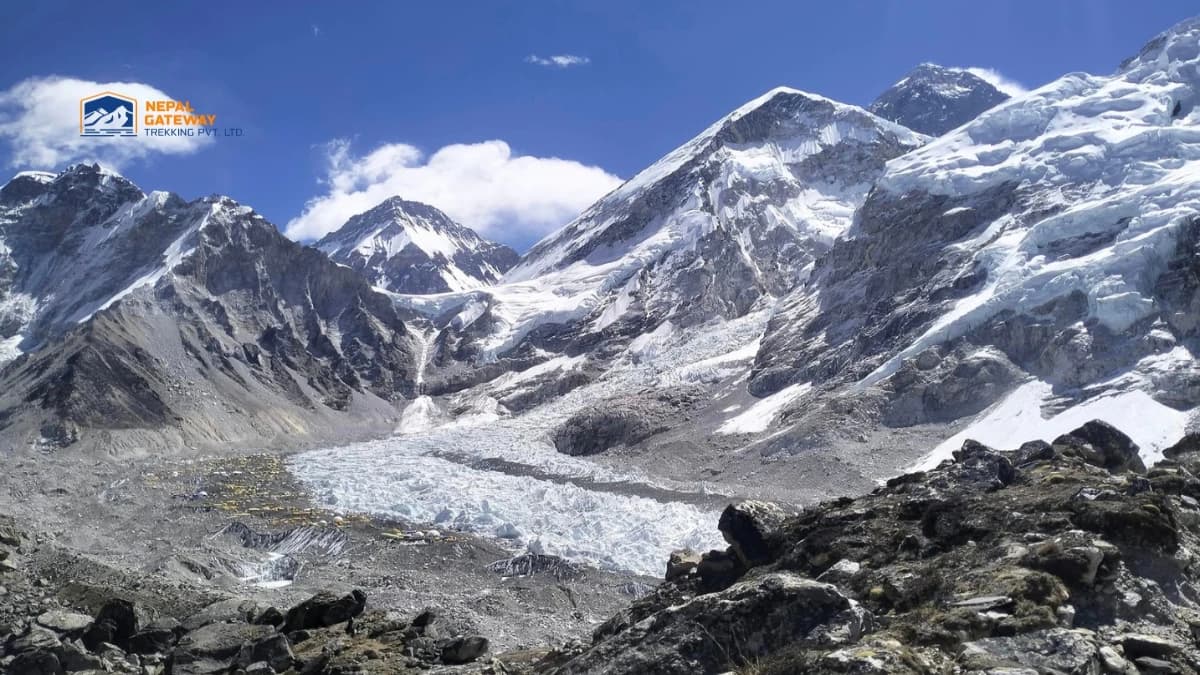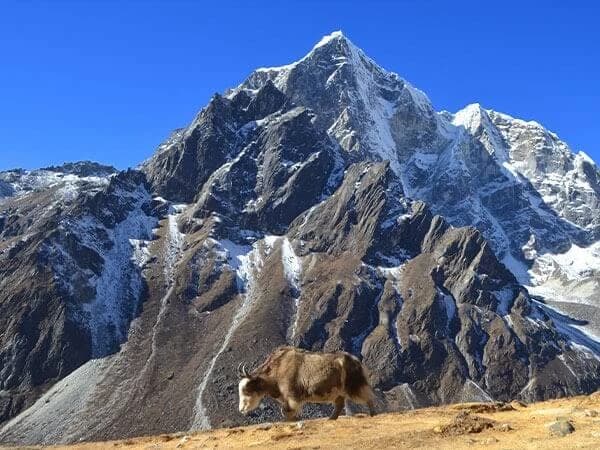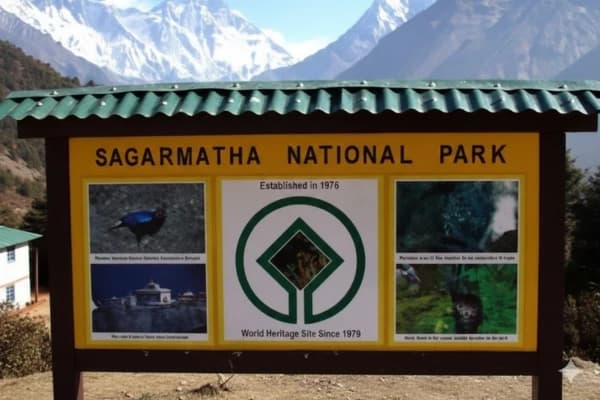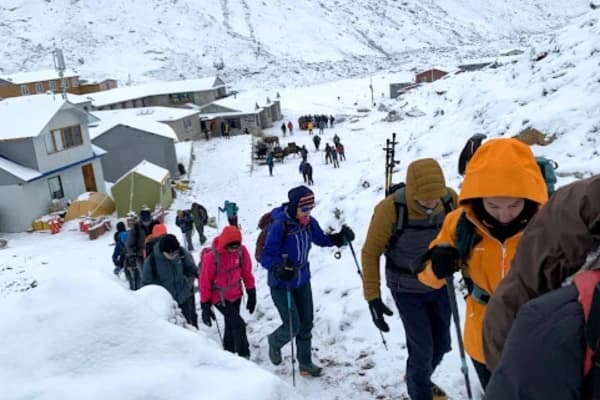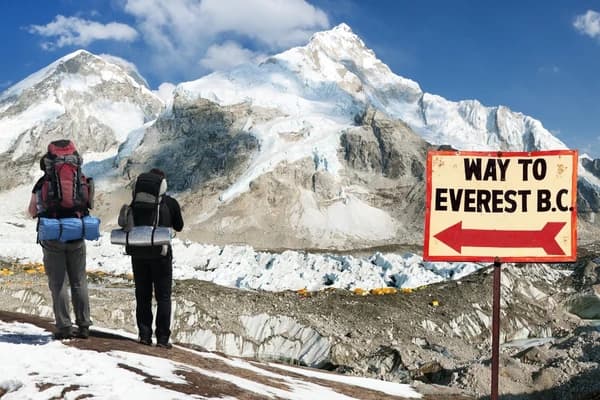The Everest High Passes Trek is considered one of the world's most breathtaking and challenging treks. It takes you over three high mountain passes—Kongma La, Cho La, and Renjo La - offering spectacular views of Everest, Lhotse, Makalu, and other Himalayan giants. The best season to trek Everest High Passes is autumn, as you can get a view of the stunning Gokyo Lakes and cross landscapes ranging from rhododendron forests to snowy alpine meadows.
Choosing the right time for doing Everest High Passes Trek is important. Trekking in the wrong season can mean dealing with heavy rains, muddy or slippery trails, or extreme cold, risking safety and enjoyment. Many trekkers struggle with unpredictable flights, trail conditions, and lodge closures if they don't plan well.
The greatest seasons are spring (March to May) and fall (September to November), when there are bright skies, calm weather, and fully open services, making the trek safer and more enjoyable. Trekking in the off-season is feasible, but it calls for more planning and adaptability.
This guide will help you understand the Everest Three Passes trek weather, risks, and tell you the best time for Everest High Passes Trek.
Trip Highlights
- Cross three challenging high passes over 5,300 meters: Kongma La, Cho La, and Renjo La.
- Incredible views of Everest and the surrounding peaks.
- Visit Sherpa cultural hubs like Namche Bazaar and Dingboche.
- Exploration of Gokyo Lakes and alpine landscapes.
- Diverse ecosystems from forests to glaciers.
What is the Everest High Passes Trek?
The Everest High Passes Trek is an exciting and challenging route in Nepal’s Everest region. It’s different from the popular Everest Base Camp trek because it crosses three high mountain passes, each over 5,000 meters high. These passes offer incredible mountain views and test your stamina and how well your body adapts to high altitude.
- Kongma La Pass — 5,535 meters: The highest of the three passes, known for panoramic views of Everest, Lhotse, and Makalu.
- Cho La Pass — 5,420 meters: A steep and rocky pass that connects the villages of Dzongla and Gokyo, offering stunning views of glaciers.
- Renjo La Pass — 5,360 meters: Famous for beautiful sunrise views over the Gokyo Lakes and the surrounding peaks.
Are you craving a quieter, more breathtaking Everest adventure? Explore the untouched beauty of Gokyo Lakes and Renjo La Pass – your journey starts here!
When is the Best Time for Everest High Passes Trek?

The best time for Everest High Passes Trek is autumn, which lasts from late September to November. During this season, the skies are clear and bright, offering some of the most breathtaking views of snow-capped peaks like Everest and Lhotse. After the monsoon rains, the air feels fresh and clean, making it easier to enjoy the stunning mountain scenery without haze or fog.
Autumn also brings comfortable weather — cool during the day and chilly at night, but never too harsh. The trails are dry and safe, unlike the slippery monsoon or snowy winter seasons. Plus, teahouses and lodges are fully open, providing warm rest stops after long trekking days. All these reasons make autumn the most reliable and enjoyable time to explore the Everest High Passes.
Month-by-Month Trekking Conditions
Choosing the best time for Everest High Passes Trek can make a big difference in your experience. Each month brings its own weather patterns, trail conditions, and views. Below is a simple breakdown to help you understand what to expect throughout the year.
September
The monsoon begins to fade, and by late September, skies clear up and temperatures become more comfortable. This marks the early start of the autumn trekking season.
October
This is the best month for trekking with crystal-clear skies, dry trails, and perfect weather. It’s also the busiest time, thanks to reliable conditions and stunning views.
November
The weather stays clear and cool, with fewer crowds than October. It’s a great time for peaceful trekking and sharp, crisp mountain scenery.
December to February
These are the coldest months with high chances of snow, making the high passes difficult or dangerous to cross. Only recommended for experienced trekkers with winter gear.
March
Spring begins and temperatures rise, but snow and the occasional rain may still linger, especially at higher altitudes.
April
Rhododendrons bloom across the lower trails, adding bursts of color. However, clouds and light rain may appear more frequently.
May
The weather turns warmer and more humid, bringing increased chances of rain and slightly obscured views in the afternoons.
June to August
Heavy monsoon rains dominate these months, making trails muddy, slippery, and prone to landslides. Trekking is not recommended during this period.
Want to know the perfect time to trek in Nepal?
Discover detailed month-by-month trekking conditions to plan your ideal Himalayan adventure. Learn more about the best trekking seasons in Nepal
Why is Spring (March to May) a Favorite Season for Everest High Passes Trek?
Spring is popular because of its colorful rhododendron blossoms and lush green landscapes. Temperatures are moderate and comfortable, and the trails tend to be less crowded than in autumn. Many trekkers enjoy good mountain views, though weather can be less stable with occasional rain or snow on the high passes.
Pros
- Beautiful blooming rhododendrons and greenery
- Comfortable temperatures
- Fewer trekkers on the trails
Cons
- Possible snow and ice early in the season
- Occasional rain showers
- Weather less predictable than autumn
Why is the Autumn (September to November) season the best time for the Everest High Passes Trek?
Autumn is the busiest trekking season for a good reason — it offers the clearest mountain views and the most stable weather. The dry trails and steady conditions make it safer and more enjoyable. Additionally, because of cultural celebrations like Dashain and Tihar, trekkers have a unique chance to learn about local traditions at this season.
Lodges are fully operational logistically, planes operate smoothly, and obtaining trekking permits is simple. Together, these elements produce a fantastic and hassle-free trekking experience.
Pros
- Best visibility and stable weather
- Comfortable temperatures day and night
- Full lodge and flight services
- Rich cultural festival experiences
Cons
- More crowded trails
- Higher costs for flights and accommodation
- Booking in advance is necessary
If you love trekking, explore our featured trips and discover your next great adventure with Nepal Gateway Trekking.
Is The Everest High Passes Trek Doable in the Off-Season?

Yes, but trekking to the Everest High Passes route during the off-season requires more preparation, caution, and flexibility. Off-season includes the monsoon months of June to August and the cold winter months ranges from December to February.
Monsoon trekking challenges include heavy rainfall, slippery trails, landslide risks, and frequent flight cancellations. Despite these challenges, trekkers who embrace the lush, green landscapes and the solitude often find it rewarding.
However, you must be prepared for potentially closed lodges, less reliable transport, and difficult trail conditions. That's why autumn is considered the best time for Everest High Passes Trek season.
Why is Monsoon (June to August) Risky for Everest High Passes Trek?
Heavy and persistent rainfall makes trekking particularly difficult during the monsoon months of June to August. Trails becoming slippery and muddy, increasing the risk of falls and injuries, is normal in monsoon, so we need to be extra careful.
Flooding and landslides are frequent occurrences, which might occasionally force trail closures or detours that cause delays in your itinerary. The trek's primary entry point, the Lukla flights, are often delayed or cancelled due to poor visibility and bad weather.
In addition, heavy fog frequently hides Himalayan views and reduces the trekking experience. Together, these factors make monsoon trekking less enjoyable and more of a test of your stamina and flexibility.
Pros
- Wildflowers in bloom and a lush, verdant landscape
- Very few trekkers for a peaceful experience
- Lower prices for accommodation and flights
Cons
- Heavy rains make trails slippery and dangerous
- Frequent landslides and trail blockages
- Lukla flights are often canceled or delayed
- Clouds often obscure mountain views
Why is Winter (December to February) Not Ideal for the Everest High Passes Trek?
Winter trekking is physically demanding due to freezing temperatures, especially at night and on the high passes. Snow collection over time may block routes or make the pathways dangerous, causing many lodges to close in winter and limiting your accommodation options.
Flight cancellations are common due to snow and fog. Proper winter gear and cold-weather experience are essential for safety. However, winter’s clear skies offer some of the best mountain views, and the trails are beautiful, vibrant, and appealing to trekkers who look to bond with nature and challenge difficult trails.
Pros
- Quiet trails with few tourists.
- Clear skies offer stunning mountain views on sunny days.
- Cooler daytime temperatures with proper gear.
Cons
- Freezing temperatures and the risk of frostbite.
- Snow buildup might block the roads.
- Bad weather causes many lodges to close, which reduces the number of rooms available.
- Weather-related flight cancellations are common.
Month-by-Month Breakdown Overview
Understanding the month-by-month breakdown is essential for planning your best time for Everest High Passes Trek. Each month brings different weather patterns, temperatures, trail conditions, and experiences.
Spring vs autumn Everest trek is in debate quite a lot, while they both offer the most reliable conditions, summer and winter require more caution due to weather extremes. The table below highlights average daytime and nighttime temperatures and brief remarks to help you quickly assess which months align for the best time for Everest High Passes Trek with your goals and comfort level.
|
Month |
Avg. Day Temp (°C) |
Avg. Night Temp (°C) |
Remarks |
|
March |
8–14 |
-2 to 2 |
Cold start, snow possible |
|
April |
10–16 |
0 to 5 |
Warmer, rhododendrons bloom |
|
May |
12–18 |
3 to 7 |
Warm, good visibility |
|
June |
14–20 |
5 to 10 |
Start of monsoon, rains begin |
|
July |
15–21 |
7 to 12 |
Heavy monsoon rains |
|
August |
14–20 |
6 to 11 |
Monsoon continues |
|
September |
13–19 |
4 to 8 |
End of monsoon, clearing skies |
|
October |
11–17 |
2 to 6 |
Peak trekking season |
|
November |
9–15 |
0 to 5 |
Cool, clear skies |
|
December |
5–10 |
-5 to 0 |
Cold, snow likely |
|
January |
3–8 |
-10 to -4 |
Coldest month |
|
February |
4–10 |
-8 to -2 |
Cold but improving |
Want to see amazing views of Everest? Join the Everest Panorama View Trek with Nepal Gateway Trekking and make memories that last a lifetime. Book now!
Factors to Consider While Choosing the Best Time for Everest High Passes Trek

Choosing the right season to get the best time for Everest High Passes Trek involves more than just checking the weather. Several key factors influence the overall experience, including your budget, preferred crowd level, flight reliability, and trail safety.
Seasonal changes also impact lodge availability, acclimatization opportunities, and comfort with cold or wet conditions. Understanding how these elements shift month to month will help you match the best trekking window to your fitness level, expectations, and travel style. We break down each factor in the sections below to guide your decision.
Budget
Your budget will determine when you can trek in the best possible condition. Peak seasons like spring and autumn attract tourists, pushing up flight, accommodation, and guide prices. Bookings are often necessary, which means committing your budget early. In contrast, off-season trekking during monsoon or winter is generally cheaper.
Weather Condition
Weather is the most determining factor affecting your trek’s success and safety. Stable, dry weather with clear skies enhances visibility, makes trails safer, and improves the trekking experience. Spring and autumn usually provide this ideal weather.
Monsoons bring heavy rainfall that can cause dangerous trail conditions, landslides, and flight cancellations. Winter’s extreme cold and snow present risks of frostbite, hypothermia, and blocked passes. Check detailed weather forecasts and historical data before booking.
Flight or Road Transport
Most trekkers fly into Lukla for the Everest High Passes Trek. Flights to Lukla are highly weather-dependent so frequent flight cancel during monsoon and winter due to poor visibility, fog, or storms is normal.
Frequent flight cancel during monsoon season and during peak season are a norm, and flights are often diverted to Ramechhap airport to reduce congestion in Kathmandu.
Note about Lukla Flight: When Lukla flight route is cancelled then trekkers can go via road routes from Jiri or Salleri to get to the Everest High Passes, though these add several days and may have less reliable transport options.
Trail Condition
Trail conditions vary dramatically by season. Spring and autumn usually have dry, firm paths that reduce slipping risks. Monsoon trails can become muddy, slippery, and dangerous, with swollen rivers and landslides causing detours or delays.
Winter trails may be icy or blocked by snow, requiring technical gear like crampons. Research current trail conditions and speak to trekking agencies for up-to-date information before your trek.
Crowd
If you prefer solo-like and quiet trekking, avoid peak trekking months when the Everest region is busy with hundreds of trekkers daily. Spring sees fewer crowds than autumn, but the difference isn’t huge. Off-season trekking has fewer people on trails and villages, offering a more peaceful experience. However, some services may be limited or unavailable during the off-season.
Personal Preferences
Your preferences-whether you prioritize mountain views, cultural festivals, comfortable temperatures, or solitude-should guide your timing choice. Spring offers blooming flowers and moderate crowds; autumn brings the clearest views and vibrant festivals; the monsoon brings lush greenery and quiet trails; and winter appeals to experienced trekkers craving challenge and solitude.
Looking for a trek that fits you perfectly? Customize your trip with Nepal Gateway Trekking today.
Things to Consider to Make Your Trip the Best Trip of a Lifetime
To make it the best time for Everest High Passes Trek and remembering the trip of a lifetime, choose a trusted trekking company, pack season-appropriate gear, and plan extra days for acclimatization.
Stay at reliable lodges, be aware of altitude risks, and consider fun activities like rafting or paragliding when you can. Preparing ahead of time guarantees a safer and more enjoyable experience. Let's examine how you could make this vacation worthwhile in more detail.
Choose the Right and the Best Trekking Company
Working with a reputable and well-known trekking company such as Nepal Gateway Trekking guarantees that you will have safety assistance, secure lodging that meets your standards, and guides who are well-versed in the trek. We adapt to your requirements and support you through unforeseen shifts.
Selection of the Lodges
Choose lodges that offer clean rooms, hot showers, and nutritious meals to help you rest well and recover from demanding trekking days. These factors will decide if you get a good rest and enough energy for the next day of trekking.
Highly Knowledgeable Trekking Guide and Support Crew
Experienced guides are very important to navigate altitude sickness risks, weather changes, and local culture, making your trek safer and more enjoyable. A good support crew can make your trip much easier and enjoyable as they are battle hardened for these kinds of job.
Packing the Right Gears for the Trip
Layered clothing, waterproof jackets, sturdy boots, sleeping bags suitable for the season, and trekking poles are essential. Carrying the right gear prevents weather-related discomfort and injuries while improving your endurance on long trails.
Acclimatize Day and Proper Knowledge of Acute Mountain Sickness
Plan the rest of the days to allow your body to adjust to the altitude. Learning the early signs of AMS, like headache, nausea, or dizziness—and knowing when to descend—can be the difference between a safe trek and an emergency.
Adding Extra Activities Like Rafting, Jungle Safari Tour, Paragliding, etc.
Enhance your overall Nepal experience by combining your trek with other adventure activities before or after your trek. These add-ons balance the physical challenge of trekking and let you explore Nepal’s rich biodiversity and thrill-seeking side.
Final Thoughts: When is the best time for Everest High Passes Trek?
The best time for Everest High Passes Trek is autumn (September to November) and spring (March to May) due to stable weather, stunning views, and complete services. Off-season trekking is possible for experienced adventurers with proper preparation.
Choose your trekking season based on fitness, budget, and personal preference. Trust Nepal Gateway Trekking for expert guidance and a memorable journey.
Contact us today to book your unforgettable Himalayan adventure!
FAQs
What is the best time for Everest High Passes Trek?
The best time for Everest High Passes Trek would be April, May, September, and October. These are the best month to trek Everest High Passes as they offer stable weather, clear skies, and comfortable temperatures, making trekking safer and more enjoyable.
Can I trek the Everest High Passes in the winter season?
Yes, trekking in winter is possible, but challenging due to the very cold climate. Expect temperatures to drop sharply, snow-covered routes, and limited lodge availability as most places close down due to the cold. It’s recommended only for experienced trekkers with proper gear.
Is trekking possible during the monsoon?
Trekking during the monsoon (June to August) is doable but risky due to heavy rains, slippery trails, frequent landslides, and flight cancellations. It’s best suited for adventurous trekkers prepared for wet conditions.
What is the Everest High Passes Trek difficulty like?
The trek is moderately challenging because it involves crossing three high mountain passes above 5,300 meters, requiring good fitness, acclimatization, and trekking experience.
Do I need special permits for this trek?
Yes, you do. Depending on your exact route, you will need a TIMS card (Trekkers’ Information Management System) and an Annapurna Conservation Area Permit (ACAP) or Sagarmatha National Park Permit.
Are lodges open year-round on this trek?
Lodge availability varies by season. Most lodges operate entirely during spring and autumn. In winter and monsoon seasons, some lodges close or offer limited services.
What are the key acclimatization stops?
Important acclimatization stops include Namche Bazaar, Dingboche, and Chukung. These villages allow the body to adjust to increasing altitude gradually.
What gear should I pack for spring trekking?
Pack layered clothing, a warm sleeping bag, a waterproof jacket, sturdy boots, gloves, hat, sunglasses, and trekking poles. Weather can vary, so be prepared for cold mornings and warmer afternoons.
How crowded is the Everest High Passes Trek in autumn?
Autumn is the busiest season, especially in October, with many trekkers on the trail. Lodges fill quickly, so early bookings are recommended to avoid overcrowding.
Why choose Nepal Gateway Trekking for Everest High Passes Trek?
Nepal Gateway Trekking offers expert guides, reliable logistics, personalized service, and a strong commitment to safety and sustainability, ensuring a smooth and memorable experience as they will suggest you the best time for Everest High Passes Trek.
